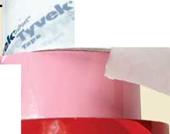Seam Tape and Fasteners Are Vital to the System

 It never ceases to amaze me how many builders omit seam tape from housewrap installations. Although proper lapping is enough to create a watershed, all seams must be sealed to stop air infiltration. Taping the seams also helps to preserve the housewrap’s integrity throughout construction and makes the membrane less likely to catch the wind and tear.
It never ceases to amaze me how many builders omit seam tape from housewrap installations. Although proper lapping is enough to create a watershed, all seams must be sealed to stop air infiltration. Taping the seams also helps to preserve the housewrap’s integrity throughout construction and makes the membrane less likely to catch the wind and tear.



 Seam tape also provides a means to repair cuts, but every cut or penetration should always be treated like a horizontal or vertical seam. Seam tape is never used to make up for improper lapping. In fact, assume that the tape adhesive will fail eventually, allowing water to penetrate the drainage plane and wet the framing. In contrast, a proper lap can last forever.
Seam tape also provides a means to repair cuts, but every cut or penetration should always be treated like a horizontal or vertical seam. Seam tape is never used to make up for improper lapping. In fact, assume that the tape adhesive will fail eventually, allowing water to penetrate the drainage plane and wet the framing. In contrast, a proper lap can last forever.
Almost every housewrap manufacturer provides a seam tape for their product. Generic building tapes such as duct tape should be avoided because they might fail sooner.
Housewrap can be attached with plastic cap nails (see the photo, near right), l-in.-wide crown staples, or large-head roofing nails. Many builders use a hammer tacker to fasten the wrap with staples, but this type of fastener is much more likely to pull through the housewrap before the siding is installed.
For a better installation, manufacturers recommend the use of plastic cap nails or cap screws, which are available for manual fastening or collated for use in pneumatic nailers (see the photo, far right). Cap nails also act as a gasket to keep water from leaking through the nail holes.
Whatever fastener is used, the manufacturer’s recommendations for spacing are important. The most common spacing is 8 in. to 18 in. vertically, and 16 in. to 24 in. horizontally. Fasteners should be driven into studs or sheathing such as plywood or OSB.
Housewrap installation starts from the bottom and works its way up. All horizontal joints should overlap at least 6 in., and all vertical joints 12 in. If housewrap is applied to the sheathing before the wall is raised, there needs to be enough material left to cover the band joist. Horizontal laps are as important as vertical laps because windblown rain can travel sideways.
Housewrap should always be installed with the same care and attention devoted to siding. Although no one will see good work underneath the siding, correctly installed housewrap still pays off in the long run.
Fernando Pag6s Ruiz operates Brighton Construction Co. in Lincoln, Neb. He is also the author of Building an Affordable House: Trade Secrets for High-Value, Low-Cost Construction (The Taunton Press, 2005).






Leave a reply